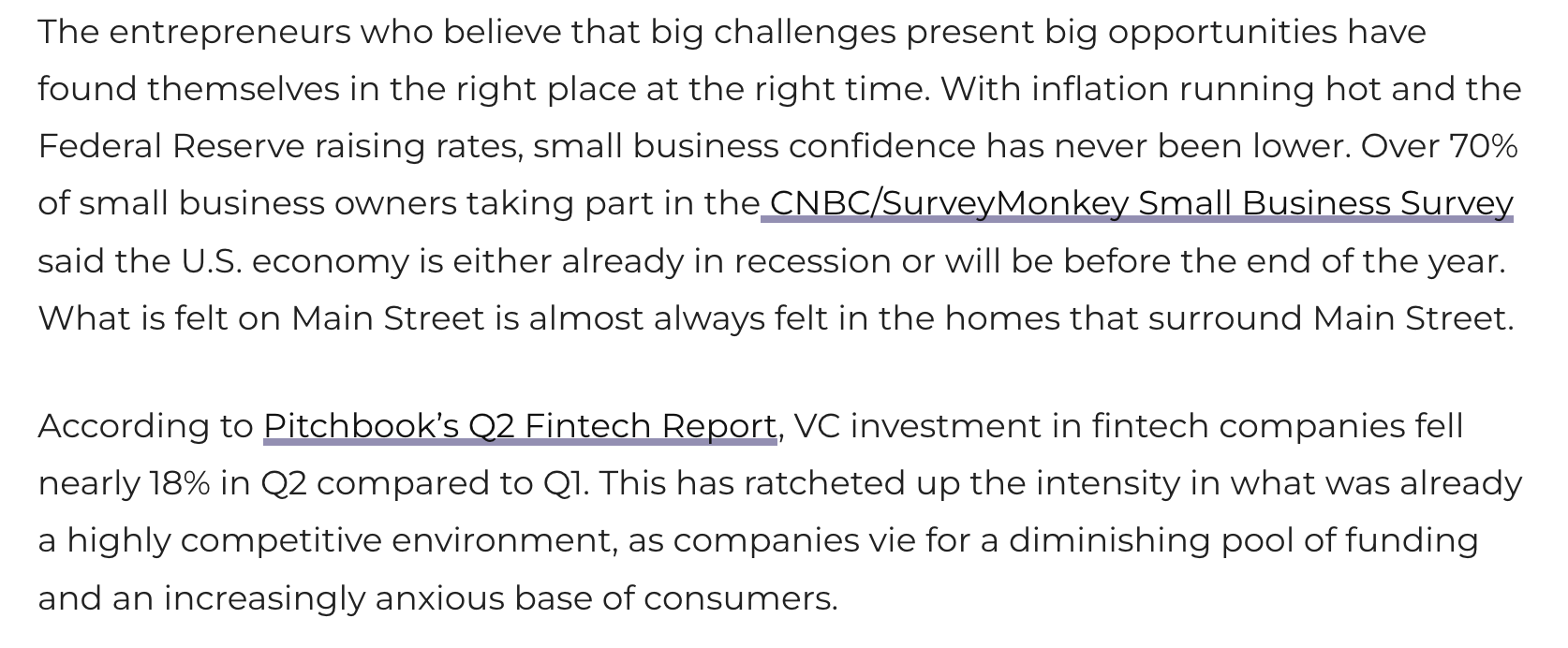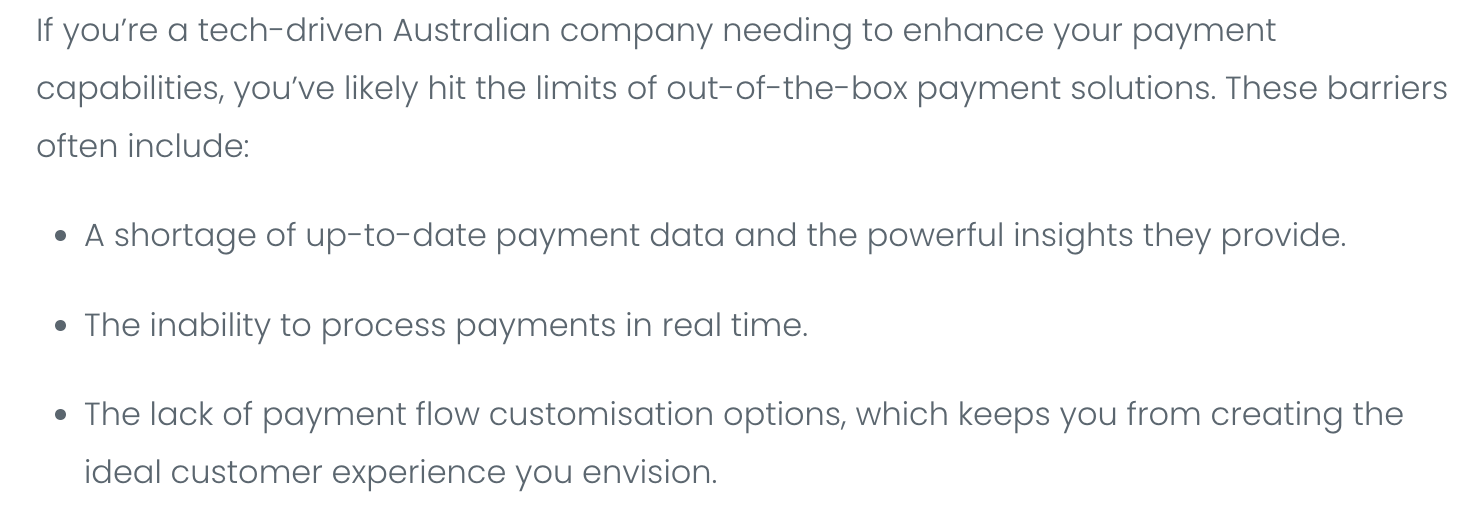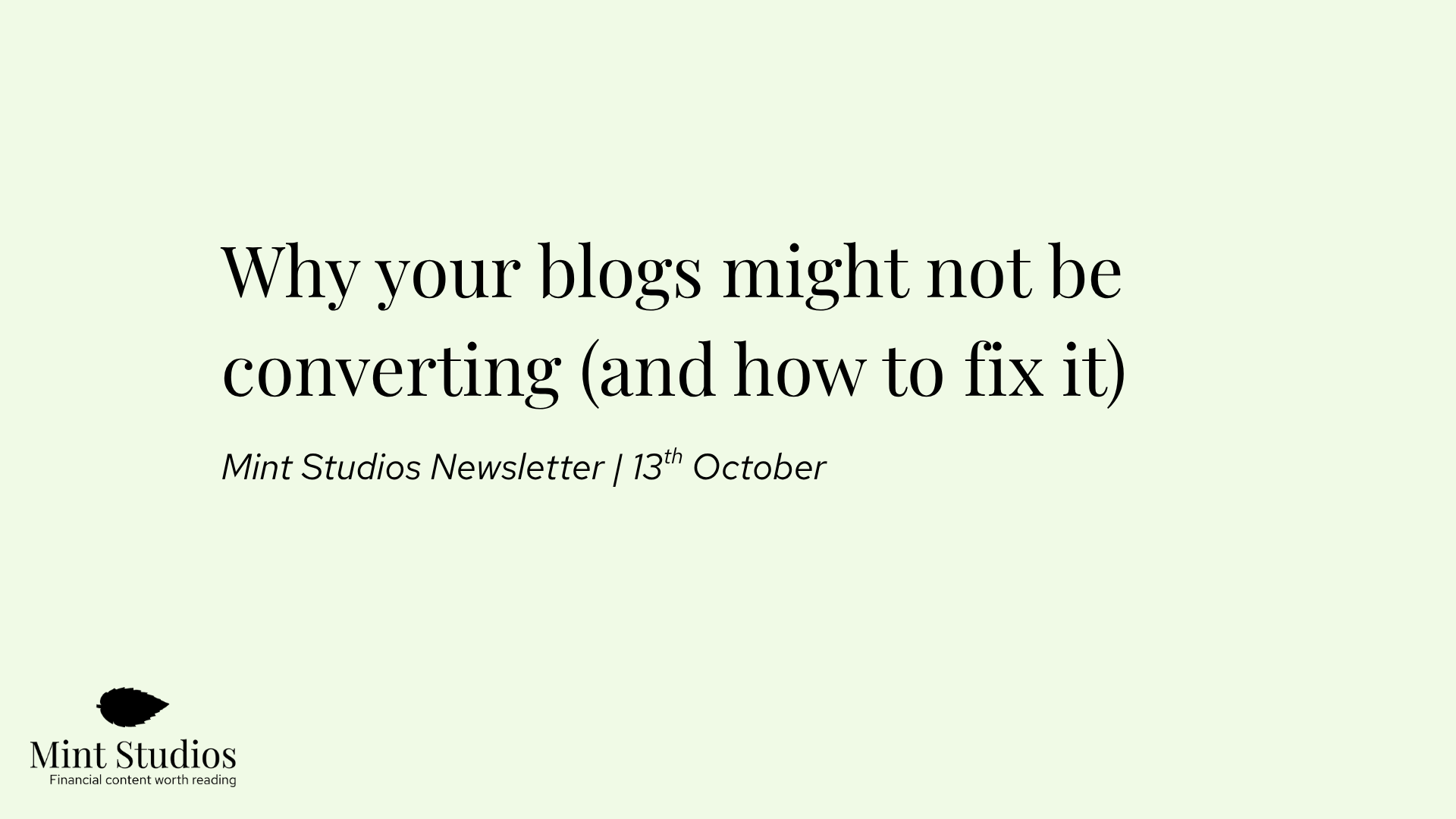At this moment, do you know how many leads and sales your website blog brings?
If the answer is no, it probably means you could be doing a lot more with your blog. What if we told you that you could generate 5 - 10 SQLs per month with your payments blog?
10 SQLs might not seem like a lot, but if these are incredibly high quality leads with high close rates and annual value of over $100k, then we’re talking about potentially half a million in business every month. Now that’s a pretty decent number.
A lot of people think the blog is a nice-to-have where you write about lifestyle topics, updates on the company and some sort of “thought leadership”. Head to most payment companies’ websites, and you’ll see generic content that makes you wonder: does anyone really read this?
But we’re not saying payment companies should not create content. We’re going to make the argument that payment companies should in fact invest MORE in content. But not the type of content that they are currently investing in: something completely different.
As you’ll see below, very few payment companies are investing in the right type of content, which is why there is such a huge opportunity.
We’ve worked with a couple of payment companies, and just by ranking for highly specific keywords on Google and creating in-depth, advanced content, we’ve been able to generate multiple SQLs per month, worth over $500k+ a year for them.
Note: want to learn more about what we do? Read about how we help fintech companies make the most of their blog with our framework.
The opportunity: generating SQLs via the blog
Why is it that content is such a great way to generate SQLs for payment companies? And how come no one is doing it? Let’s look into it.
The payments industry is a B2B consultative industry: education is important
The payments and B2B financial services industry is a sales heavy industry. Contracts are worth multiple hundreds of thousands because they are based on the number of transactions their customer (a business) does.
These are often sales-led organisations where the team is in charge of finding prospects, understanding their issues and then helping them build a solution based on those needs. As with anything in the B2B consultative industry, there’s a lot of education and hand-holding involved.
Some of their target customers might be new to the payments industry and don’t know how to build payments in a way that complements their business model. Often, the company doesn’t know that they have a payment problem that could be solved with an API.
The key factor here is: education is important. Not just on the product, but also on the problem and the potential solution. These are long sales cycles, where both the provider and the potential client will spend months working together on building a solution.
Sales people rely on marketing collateral and other documents to help them with the sale. Content is already a big part of the payments industry, but it’s used for sales enablement. Not for customer acquisition.
That’s where the flaw as well as the opportunity lies: the content that you’re using for sales enablement, publish it on your website – specifically, the blog. But make it public, and consider using it for customer acquisition purposes. As we’ll see below, more people prefer doing their own research online before reaching out to a salesperson.
You may like: How This Payments Company Gets 75% of Leads Inbound and a 59% Close Rate with Content Marketing
Product managers and Head of Payments do use Google
The other objection we hear is that people believe that their target market doesn't use Google. This might be true for relationship based business (e.g. finance brokers, investment advisers, financial advisers), but it’s not true for B2B high ticket payment products.
If that weren’t true, we would not be seeing the SQLs we are generating for our clients, and this screenshot would show all 0s:

They do use Google, of course they do. And why? Because they use Google in their everyday life. When you’re looking for new restaurants, comparing bicycles and buying baby clothes, you go to Google. So why would you act differently in the B2B setting?
Most content written by payment companies isn’t great (and is for the wrong purpose)
This is where the real opportunity is: most payment content isn’t great.
Most payment companies are writing blog content for the wrong audience: people who are not buying. They write content for beginners, for consumers and for laypeople who would never take an interest in payments.
Here are some of the titles we’re talking about:



If your ideal buyer is someone relatively technical, is maybe new to payments but is involved in the industry, then they are unlikely to read this. Even if this was great content, how is it reaching them? It’s not ranking on Google. It’s unlikely people click through from LinkedIn or Twitter. So how are people reading your pieces?
This is especially true when the article starts off like this:

“The entrepreneurs who believe that big challenges present big opportunities have found themselves in the right place at the right time.”
What entrepreneur does NOT believe that big challenges present big opportunities? 🤷🏻♀️
Our point is: these companies have it all backwards. The reason they publish content like this is usually because they have an allocated marketing budget to fill, and therefore are obligated to spend it on creating content that no one will read and serves no purpose. OR, they create fantastic, expert-based content, but don’t have a distribution method – so no one reads it.
There is a huge opportunity here to create good payments content that is advanced, written for the right audience and then ranks on Google to attract customers, or has a strong distribution strategy. Many payment companies have incredibly intelligent experts on their team, but most do not interview them and use that knowledge.
Compare that paragraph above, with something we wrote for our payment client:

At least it’s clear here who it’s written for!
The financial ROI can be significant
There are multiple ways you can track the ROI of blog content: through social engagement, number of downloads from gated content or click throughs via email.. However, few payment companies take advantage of the fact that they could track and get a positive financial ROI from their blog.
That means people who read the blog, and then submit an enquiry and become a prospect. As we said above, we know from experience that generating 5 - 10 SQLs is very feasible for a payments company. Yes, it can be tracked via Google Analytics or HubSpot, and yes it can generate first and last touch attributed contacts.
You can even put it into a spreadsheet and do the numbers. With a close rate of 1%, and content costs of $5k per month, you only need 6 SQLs to get a positive financial ROI. It’s a no brainer.

But then you might say: how can you be sure that these are high quality prospects with high close rates?
That’s the beauty of content marketing: by creating in-depth, expert based content that targets specific keywords your ideal buyer might be looking up, you are targeting prospects who are a lot more likely to convert. We’re not saying you want to try to rank for keywords like “payment methods” or “embedded finance”, we’re saying ranking for much more specific keyphrases like “faster payments API” or “direct debit API”.
Someone looking that up is actively looking for your solution. They have identified their issue, identified the potential solution and are actively looking for it. Why not target these people first, before trying to target “embedded finance” and “payment options”?
That’s where the opportunity lies. Most people create content for beginners, targeting keyphrases that their target market isn’t actually searching for. What if you could create advanced, in-depth content targeting keywords that your target market is actually looking for? That’s when you’ll see SQLs coming through.
The financial ROI is significant for payment companies at the moment because there is a big opportunity. If tomorrow all payment companies tried to create this type of content and rank for the same keywords, this would no longer be the case.
But that won’t happen any time soon for a couple of reasons:
- It’s very hard to write and publish great content on payments. When’s the last time you read something on payments that was great AND public facing? There are very few freelance writers who specialise in payments and can write sales focused content. There are very few content agencies who do that as well.
- Many fintech companies are cutting marketing budgets in 2023 and since they believe the blog doesn’t bring in revenue, they won’t invest more into it.
If you have the right resources in place, are being told to focus on revenue and want content to play a large role in your marketing, creating Bottom of the Funnel content that targets potential buyers via Google could be a channel that works well for you. If you want to learn more about how to execute that, read the following blogs:
- What is BOFU (Bottom of the Funnel) Content and Why Is it Important?
- Can Blog Content Bring in SQLs for Enterprise B2B? Yes, and Here's How
- Why You Should Create Content Based on Interviews With Experts
And if you’re looking for us to help you get it right from the start, reach out to us below. 👇











